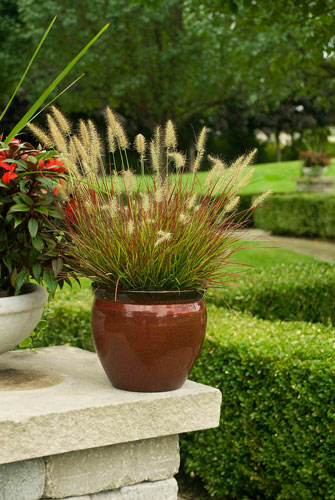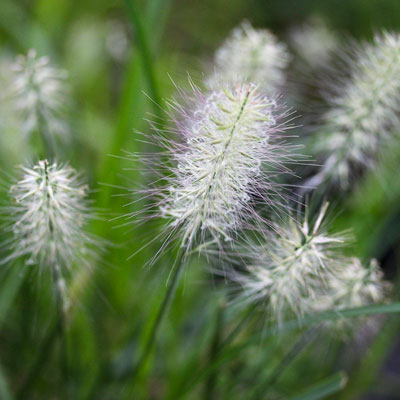6/1/2024
The Heart of Hardy Pennisetum
Lowell Halvorson

Hardy pennisetums are those mid-height grasses with the foxtail plumes, the ones that handle winter down to at least Zone 6. Others exist—like rubrum, Fireworks or Vertigo—but the industry treats them as décor annuals. Most hardy cultivars are seedlings of the P. alopecuroides species (still a strong seller) or occasionally P. orientale. A phenomenon of this grass is that seedlings don’t always come true to the parent, so variations have entered the marketplace as experts have found them: the pale Cassian from Kurt Bluemel, Burgundy Bunny from Walla Walla Nursery, Desert Plains from Walters Gardens, Red Head from Intrinsic and the P. orientale Karley Rose from Sunny Border.
Pictured: Miniatures, or mini-penns, are small enough to fit comfortably in outdoor pottery. Burgundy Bunny (pictured) has red-tipped blades that turn fully red by the end of the season. Lumen Gold stays lime-green the entire season and has very short, nearly white foxtails similar to Little Bunny. The fine foliage on all three translate into a short border hedge for a front garden.
Hardy pennisetum came into the vocabulary of landscapers with the new modern movement of the ’60s and ’70s. Designers swapped out blocks of static garden color for architectural forms that generated movement: fluttering flags of miscanthus plumes, whirling blades of bouteloua, waterfall rhythms of hakonechloa, or tall, reedy rustles of andropogon. The graceful wavy nature of the pennisetum’s foxtail bristles fits into the same philosophy of Calder mobiles and other kinetic works of public art.
Where are the sales today?
Rather than fading away like the songs “The Streak” or “Junk Food Junkie” (good Lord, have pity on me), grasses have entered the casual vocabulary of today’s American landscape. What was daring is now mundane and everywhere you look. In short, this is a category that chugs.
Commercial: Popular in places like plazas, dealerships, frontages, malls and parks, hardy pennisetum is one of those set-and-forget plantings. These grasses bloom better in lean soils, have dependable autumn looks with winter interest and—crucially—mature lower than a car window. Parking lots are everywhere and they need decoration.
Autumn retail: As a warm-season grass, pennisetum comes into retail prime for the autumn. Although growth in the foliage is triggered by soil warmth, the plumes pay attention to daylength. Pennisetum is showy in August and September, and the hardy ones help to round out the fall perennial collection.
Décor work: If you already work with annual pennisetums, consider adding some perennial versions. Annual and perennial gardens are mixing more and more these days, and those foxtail bristles add a unique flourish toward the end of the season. Fog, dew and frost make them even more dramatic. Some of your base will pick up on this look, attracting new clients.

Variations on the pennisetum theme
Bristles: Pennisetum’s signature feature, the bristles, is where most of the cultivar variation occurs. Cassian is very white and fluffy. Jambalaya has a stiff, vaguely wheat-like habit. Karley Rose has the same wheat colors, but likes to curl and drape its foxtails. Red Head and Cayenne have thick, dark seed heads.
Miniatures: A whole lot of fun occurs within the mini-penns. Most of the hardies mature about waist-high, but several Bunnies and a Piglet roam around about a foot off the ground. Lumin Gold is a foliage-first cultivar; blades are thin, fine and lemon-lime in color. The habit bulks into that classic carex waterfall dome. Its polar opposite is Burgundy Bunny, a miniature that leans hard into the reds. They work off each other in containers, in mixed plantings or just running around in a low border garden.
Pictured: Color variations are most notable among the different foxtails. They can range from nearly white as in Hush Puppy (pictured) or Cassian, the standard wheats of Jambalaya or Hameln to the dark chocolates of Water to Wine or Ginger Love. If you like some curl in your tail, go with Karley Rose.
The Infertile Grass Collection
Pennisetum doesn’t have the free-seeding rap that miscanthus has, but Hameln and the species P. alopecuroides do reseed. The issue is usually controlled with mulching, but some regions can be sensitive in this regard.
The Infertile Grass Collection is the breeding program developed by the University of Georgia to create seedless or nearly seedless ornamental varieties. You know their prior work, such as Princess Caroline and Vertigo. About half a decade ago, they also released five pennisetums hardy to Zone 5:
■ Cayenne—Thick, dark bristles; very upright habit; darkest head color
■ Etouffee—Blonde; long foxtails; high stem count
■ Hush Puppy—Pale pink; fluffy blooms; tallest plant
■ Jambalaya—Long, stiff, wheat-colored bristles; very upright habit; high stem count
■ Praline—Blonde; short, mostly dome-like bristles; taller plant
Notice how the cultivars share their names with New Orleans dishes. This theme ties the grasses together as a series and identifies them as a cohesive breeding group.
Pennisetum health
Trimming: Cut pennisetum flush to the ground. Winter stems above the ground are just dead matter and establish a habitat for spittlebugs and other pests. Flush cuttings extend the life of a planting because the tall stems encourage the center to eventually die out from a damp rot.
Soil: If you like your pennisetum bulky, feed it. All that energy will go into the blades. However, if you want lots of seed heads, keep the soil lean. Less nutrition diverts resources into a more abundant display.
Zone: Hardies can handle hard colds in Zones 5 and 6, and Hameln pushes into Zone 4. Winter doesn’t kill plants; however, a thaw-freeze-thaw wakes the crown only to kill it. This is why plantings further north survive, especially if they have a good layer of mulch over the top. GT
Lowell Halvorson is a consultant and writer in Fairfield, Connecticut, for retail and wholesale horticulture, specializing in business development. He also covers the breeding community for GrowerTalks magazine. You can contact him at (203) 257-9345 or halvorson@triadicon.com.